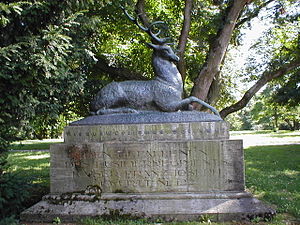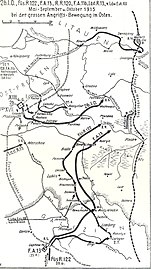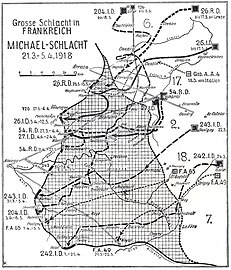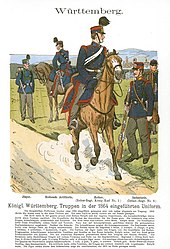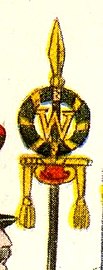Fusilier regiment "Emperor Franz Josef of Austria, King of Hungary" (4th Württembergisches) No. 122
|
Fusilier regiment "Emperor Franz Josef of Austria, King of Hungary" (4th Württembergisches) No. 122 |
|
|---|---|
| active | 1806 to 1919 |
| Country |
|
| Armed forces | Württemberg Army |
| Branch of service | infantry |
| Type | Infantry Regiment |
| structure | See outline |
| Insinuation | XIII. (Royal Württemberg) Army Corps |
| Location | See garrisons |
| march | Presentation march: "March King Friedrich Wilhelm III" Parade march : " Radetzky march " (AM II, 120) |
| management | |
| Commanders | See list of commanders |
The fusilier regiment "Emperor Franz Josef of Austria, King of Hungary" (4th Württembergisches) No. 122 was from 1806 to 1919 an association of the Württemberg army .
history
Surname
On May 15, 1807, the regiment was the Fusilier - Bataillon by setting up a second battalion from the 5th of Etzdorff companies of Musketeer formed battalions of lilies mountain and Seckendorf. On September 17, 1809 it was renamed the Fusilier Regiment "von Koseritz" , on May 17, 1811, it was renamed Infantry Regiment No. 7 , and on October 13, 1813, it was renamed Infantry Regiment No. 8 . With the military reform of 1817 it was called the 4th Infantry Regiment from March 31, 1817 .
After the military convention with the North German Confederation of 21./25. On November 2, 1870, like all Wuerttemberg troops, it received the corresponding addition of 4th Württemberg Infantry Regiment on October 2, 1871 to distinguish it from troops from other German states . On December 18, 1871, all Württemberg regiments received additional numbers. These corresponded to the consecutive numbering of all regiments of the German Armed Forces, regardless of their affiliation to one of the contingents. The regiment was given the number 122 and thus became the 4th Württemberg Infantry Regiment No. 122 . On December 14, 1874, all troop units received the final spelling and numbering: Infantry Regiment (4th Württembergisches) No. 122 . After the appointment of a chief on January 9, 1892, it was called Infantry Regiment (4th Württembergisches) No. 122 “Kaiser Franz Joseph v. Austria, King v. Hungary ” and on November 10, 1906 was given the name Fusilier Regiment“ Kaiser Franz Joseph v. Austria, King v. Hungary "(4th Württembergisches) No. 122 .
On April 30, 1919, the regiment was disbanded.
The tradition of the regiment in the Reichswehr was taken over by the 5th and 7th companies of the 13th (Württ.) Infantry Regiment .
Garrisons
- 1806 Hohenasperg
- 1807 Gundelsheim
- 1809 Horneck Castle
- 1810 Stockach
- 1810 Crailsheim , Hall
- 1813 Hohenasperg
- 1815 occupation in France
- 1818 Heilbronn
- 1833 Stuttgart
- 1852 Ludwigsburg
- 1866 Ulm
- 1871 1st Battalion Ulm, 2nd Battalion Mergentheim
- 1872 1st Battalion Ludwigsburg, 2nd Battalion Mergentheim
- 1873 III. (Fusilier) Battalion Ludwigsburg
- 1879 Hohenasperg
- 1883 Ludwigsburg
- 1890 Gmünd
- 1897 Heilbronn
- 1893–1895 IV. Battalion Gmünd
- 1897 Heilbronn
- 1914 2nd Battalion Mergentheim
Participation in skirmishes and combat operations
- 1806/07 on the side of France against Prussia , strength 39 officers , 133 NCOs and 1,268 men in 2 grenadier and 6 fusilier companies. The regiment did not participate in any combat operations and was garrisoned in Glogau .
- 1809 on the French side against Austria in the Vandamme division . Strength 31 officers and around 1,419 men. The regiment fought near Linz and Traismauer .
- 1812 on the French side against Russia in the Ney Army Corps , 33 officers and around 1,400 men. The regiment moved out as a garrison from Danzig on April 6, 1811 and was garrisoned in Königsberg at the beginning of 1812 . After the Battle of Borodino , the remnants of the Württemberg infantry were formed into three battalions. After the battle of Borisov on November 22nd, 1812, the regiment was still around 100 men strong, only 53 men came back from Russia. However, all flags were returned.
- 1813 on the part of France against Russia / Prussia in III. Army Corps Reynier , strength 30 officers and 1,175 men. Used in Bautzen , Groß-Rosen, Jüterbog and Euper, among others . After the battle of Dennewitz , the remnants of the Württemberg infantry, the regiment still 1 officer and 70 men strong, were formed into three battalions. The regiment was not used in the Battle of Leipzig and marched back to Württemberg. All flags have been returned.
- 1814 in the war against France with the main army (Württemberg Corps in IV. Corps), strength 14 officers and 716 men. The regiment was initially assigned to the 10th Light Infantry Regiment as 2nd Battalion, but took part in the Battle of Paris again as an independent regiment.
- 1815 against France in the 4th Army " von Schwarzenberg ", strength around 1,400 men. The regiment stayed in Alsace until 1818.
- In 1849, during the repression of the Baden Revolution , the 1st Battalion of the regiment (13 officers, 558 men) with the 2nd Battalion of Infantry Regiment No. 4 was Reinhardt's Combined Infantry Regiment in the Prussian Army Corps of Peuker near Käfertal and Gernsbach used
- During the German War in 1866 , 10 companies of the regiment formed the garrison of the Federal Fortress of Ulm
- 1870/71 against France . The 1st Battalion provided crews in Ulm, Stuttgart, Haguenau , Zabern , Baccarat , Épinal , Saarburg and Strasbourg and provided stage services
- In 1900 , 9 NCOs and 81 men took part in the second international expeditionary force in China.
- In 1904/06 the fight against the Herero took part in 3 officers, 10 NCOs and 57 men of the regiment. Losses: 2 killed, 1 wounded, 6 dead.
- During the First World War , the regiment initially fought within the 26th Division (1st Royal Württembergische) on various fronts.
- The XIII. Army Corps initially fought in the Argonne .
- From December 1, 1914, the 26th (Württemberg) Infantry Division and the 25th (Hessian) Reserve Division (with subordinate Württemberg Field Artillery Regiment 13) formed the "XIII. Corps Fabeck ”with the 9th Army ( Mackensen ) in Poland, which advanced to the Bzura near Kozlow . In March 1915 the XIII. Corps of the 12th Army subordinated to Gallwitz and relocated north to Przasnysz .
- On May 17, 1915, the regiment joined the 209th Infantry Brigade of the newly established 105th Infantry Division and took over the border protection in the Belgrade area . During the major offensive in the east from June, the regiment (reinforced by the 4th Landwehr Squadron XIII) advanced into the area north of Brest-Litovsk by July . After that, the division was moved to the south and was from October 6th in the offensive against Serbia in the Corps v. Winckler the 3rd Austrian-Hungarian. Army (von Köveß) deployed, the regiment reached Veles under constant combat and was deployed from November 13th to June 18th 1916 to protect the railway lines and the border with Greece between Vardar and Lake Dojran .
- In June 1916, the regiment moved by rail to Galicia to the German-Austrian-Hungarian corps Count Bothmer and was defensive battles at Karolówka (Burgau) on August 7th (only 450 men left) and at Byszow at the beginning of September during the Second Brusilow Offensive almost worn out. Then it was relocated to Courland on the Daugava in September and remained in a quiet position near Jakobstadt from September 15 to February 15, 1917 (by replacing it again a strength of 77 officers, 2,863 men and 380 horses).
- In February 1917 the regiment was transferred to the western front, trained in Lorraine for trench warfare, from April to May first as an intervention regiment, then in positions on the Aisne and from September before Verdun .
- In 1918 the regiment fought in the spring in " Operation Michael ", in August on the Somme, in September in Flanders, and from October back in northern France ( Maubeuge ). In the retreat fights it went back to the Antwerp-Maas position .
- After the armistice in Compiègne , the march back via Spa , Siegburg and Ferndorf to the Waldeck area (arrival December 5). From there the regiment reached its peace garrison in Heilbronn on foot from December 15, via Kissingen and Mergentheim (January 1, 1919), and on January 4, 1919.
- Around 19,000 men belonged to the regiment during the war. The total losses amounted to 3,510 dead, 436 missing, 8,774 wounded and 1,933 prisoners.
assignment
The regiment had the order to lead the infantry fire fight. In peacetime, the soldiers were trained to use appropriate weapons and as patient carriers.
organization
Association membership
Until 1816 there were no major associations in Württemberg during peace . Such were only put together for individual campaigns.
With the fundamental reorganization in 1817, the Württemberg army was divided into large units for the first time in peacetime. Together with the 4th Infantry Regiment, the regiment formed the 2nd Brigade in the 1st Division . In July 1849 a reorganization of the Württemberg army was ordered again. The infantry was grouped into just one division (without a number).
From 1871 to 1914 the regiment belonged to the 52nd Infantry Brigade (2nd Royal Württembergische) in Ludwigsburg , 26th Division (1st Royal Württembergische) , XIII. (Royal Württemberg) Army Corps .
During the First World War , the regiment initially remained with the 27th Division. In May 1915 the 209th Infantry Brigade of the newly established Prussian 105th Infantry Division was assigned to the 101st Infantry Brigade in the 101st Infantry Division from February 23, 1916 and came back on July 14, 1916 105th Infantry Division. During the defensive battles at Korolówka, the regiment was briefly subordinated to the 6th Austro-Hungarian Cavalry Troop Division from July 29 to August 10.
From February 22, 1917 the regiment of the 247th Infantry Brigade was subordinate to the 8th Württemberg Replacement Division, and from April 1, 1917 to the 243rd (Württemberg) Infantry Division.
structure
Until 1871 the regiment consisted of two battalions .
In 1813 the regiment was reorganized with two battalions of 4 companies each from the 55 returnees from the Russian campaign , recruits and the 2nd battalion of the 8th Infantry Regiment .
In 1814 against France the regiment with a strength of 14 officers and 716 men was initially assigned to the light infantry regiment No. 10 as 2nd battalion and on March 15, 1814 by teams of the `` Land Regiment No. 10 '' (Landmiliz ) independent again as 2nd battalion.
On October 1, 1872, the third ( fusilier ) battalion (set up, namely 1st / Grenadier Regiment "Queen Olga" (1st Württemberg) No. 119 , 3rd / Infantry Regiment "Alt-Württemberg" (3rd . Württembergisches) No. 121 and 2nd / 7th Württemberg Infantry Regiment No. 125 , a company from the regiment), on October 2, 1893 the 4th battalion was set up as a half battalion.
Levies
- In 1859 a company joined the newly established 1st Jäger Battalion
- In 1865 2 officers and 48 NCOs and men were handed over to the formation of the 3rd Jäger Battalion.
- On November 1, 1873, the 2nd company for the formation of the fusilier battalion of the infantry regiment "Alt-Württemberg" (3rd Württembergisches) No. 121 was handed over.
All of these taxes were re-established from the regiment.
- On April 1, the IV (half) battalion was transferred to the 10th Württemberg Infantry Regiment No. 180 .
Heads of regiments
Regimental owner:
- May 15, 1807 Lieutenant General Franz Maximilian von Neubronn
- September 19, 1809 Lieutenant General Ludwig Wilhelm von Koseritz
- December 19, 1864 Lieutenant General Moriz von Miller
- January 9, 1892 Emperor Franz Joseph I.
- December 22, 1916 Emperor Karl I of Austria
Commanders
| No. | Rank | Surname | Beginning of the appointment |
|---|---|---|---|
| 1. | Colonel | Franz Karl Friedrich August von Etzdorff | November 10, 1806 |
| 2. | Colonel | Heinrich Konstantin von Dernbach | February 26, 1809 |
| 3. | Colonel | Fidelis von Breitenfeld | 1808 |
| 4th | Colonel | Karl of Lalance | April 6, 1811 |
| 5. | Colonel | Franz Xaver von Spitzemberg | February 26, 1813 |
| 6th | Colonel | Ernst Kechler von Schwandorf | July 9, 1813 |
| 7th | Colonel | Johann Karl Kechler von Schwandorf | November 9, 1813 |
| major | by Bequignol | 1813 (leader) | |
| 8th. | major | Ludwig August von Wucherer | January 27, 1814 |
| 9. | Lieutenant Colonel / Colonel | Ludwig Friedrich von Berndes | March 22, 1814 |
| 10. | Colonel | Karl Benjamin von Seeger | February 23, 1817 |
| 11. | Colonel | Karl Eugen von Imhoff-Hohenstein | December 31, 1819 |
| 12. | Colonel | Karl von Löffler | October 4, 1830 |
| 13. | Colonel | Friedrich von Hügel | December 22, 1834 |
| 14th | Colonel | Karl of the East | May 20, 1844 |
| 15th | Colonel | Otto von Moser | November 12, 1849 |
| 16. | Colonel | Gustav von Brandenstein | October 24, 1853 |
| 17th | Colonel | Karl von Baumbach | October 20, 1859 |
| 18th | Colonel | Eduard von Burghardt | April 9, 1866 |
| 19th | Colonel | Adolf von Huegel | July 20, 1870 |
| 20th | Colonel | Gustav von Brandenstein | June 21, 1873 |
| 21st | Colonel | Ernst Perger from Perglas | July 6, 1874 |
| 22nd | Colonel | August von Reinhardt | March 26, 1881 |
| 23. | Colonel | Franz von Roell | May 21, 1884 |
| 24. | Lieutenant Colonel / Colonel | Georg Wilhelm Seutter of Lötzen | March 18, 1887 |
| 25th | Colonel | Wilhelm von Schmidt | July 24, 1890 |
| 26th | Colonel | Ernst Balan | April 21, 1893 |
| 27. | Colonel | Richard von Hardegg | June 16, 1896 |
| 28. | Colonel | Theodor Kretzschmer | July 3, 1899 |
| 29 | Colonel | Ernst von Gerstein-Hohenstein | May 17, 1902 |
| 30th | Colonel | Hermann von Oßwald | April 10, 1906 to June 17, 1908 |
| 31. | Colonel | Karl von Gagstetter | June 18, 1908 |
| 32. | Colonel | Heinrich Busse | June 16, 1911 |
| 33. | Colonel | Fritz von Triebig | April 1, 1914 |
| 33. | Colonel | Armand von Alberti | December 26, 1915 |
| major | Bünger Reich |
in the war 1914–1918 (leader) |
Armament and equipment
Main armament
Rifles with a percussion lock were introduced in 1831, the Minié rifle in 1851 , and the 98 carbine from 1898 . At the beginning of the First World War, each infantry regiment had six heavy machine guns , at the end of 1917 36 heavy and 72 light machine guns .
uniform
- 1806 Dark blue tailcoat with two rows of yellow buttons, red piping on the borders and armpit flaps , high red collar and red Swedish lapels . White pants, black shoes and gaiters. Black caterpillar helmet with a high black neck on the front of the caterpillar, in front a yellow shield with the Württemberg coat of arms. White leather gear and black cartridge .
- 1813 Dark blue Colett with black collar, armpit flaps and cuffs. Black shako with brass plate and leather chin strap.
- 1814: Skirt as before, but collar, armpits and cuffs again red
- 1817: Service coat in the months of November to April a royal blue kutka (up to an inch above the kneecap), in the months of May to October a royal blue Spenzer (up to the hips), without buttons, with a closed blue collar, red Polish cuffs and a cloth belt a red border. Iron epaulettes with a silver crescent moon and a yellow cloth lining with a white company number. Black collar. Royal blue, half-width trousers (white trousers and gaiters in summer). Black shako made of felt with leather cover and black and red cockade. Black waist shoes (from 1820 short black gaiters and shoes). The leather gear (worn under the epaulettes) was white. Light gray coat.
- 1821: Royal blue Colett with two rows of silver buttons (with regimental number) on the front, red closed collar and blue Polish lapels with red piping. Blue pants with red piping.
- 1845: Shako made of sheep's wool felt with a cover of blue cloth with a white upper edge, from 1846 with a royal blue bush.
- 1849: Single-breasted blue tunic with white buttons and red collar. Armpit flaps with regimental number.
- 1864: Dark blue, red lined skirt with two rows of buttons, four buttons on the back, sleeves with red piping , shoulder flaps with shoulder bulges and blue regimental number. Dark gray pants. Dark blue hats with red piping. The epaulettes are omitted as rank badges with stars on the collar, as in Austria.
- 1871: Yellow No. 122 on the shoulder flaps. Prussian helmet ( spiked hood ) with Württemberg coat of arms and the motto "Fearless and trew"
- 1874: Uniform according to Prussian standards, but still double-breasted tunic until 1892.
banner
In 1806 the Etzdorff Fusilier Battalion was awarded two flags: red and blue squared silk with golden fringes on the sides (approx. 125 cm × 125 cm), on one side the large Württemberg coat of arms on a crowned coat of arms, on the other side the crowned signature "FR" The 2nd battalion of the regiment received two identical flags. Like all Württemberg flags, these were brought back from the Russian campaign in 1812. The regiments that were newly established after the Russian campaign in 1812 received two new flags per battalion made of dark blue silk with yellow fringes (approx. 125 cm × 125 cm) by decree of February 11, 1813, on the front the monogram FR with a royal crown, on the back the small royal coat of arms. The old ones were given to the armory. As with all regiments, on October 4, 1818, the flags were replaced by standards, which were replaced by new flags by the Supreme Order of September 3, 1851. Each battalion received a flag made of burgundy-red cloth with light green fringes on all sides. In the middle of one side was the gold and yellow crowned name “W”, the other side the Württemberg coat of arms held by a yellow deer and a black lion, the inscription “Feartlos und trew” on a blue foreign exchange ribbon and the white cross of the Order of Military Merit .
The Fusilier Battalion received its flag on December 2, 1874. It was like the flags from 1851, but without a fringe and with the crowned signature "K". It was replaced by the same one in 1900, but with the crowned signature "W".
The 4th Battalion received its flag on December 3, 1894. It corresponded to that of the Fusilier Battalion of 1851, remained with the regiment when the battalion was surrendered and was carried as a second flag by the 1st Battalion.
Others
- In 1900 the 3rd company and in 1905 the 2nd company won the royal prize.
Persons in the regiment
- November 10, 1906 General of Infantry Heinrich Pergler of Perglas ( Rear Admiral of the Imperial and Royal Austro-Hungarian Navy )
- September 7, 1909 General of the Infantry Archduke Friedrich of Austria
- September 7, 1909 General of the Infantry Archduke Franz Ferdinand of Austria
- February 25, 1913 Colonel General Otto von Marchtaler (1906–1918 Württemberg Minister of War )
In 1835 Heinrich Michael Edelmann joined the regiment as a second lieutenant .
On May 15, 1915, Heinrich Eberbach joined the regiment as a lieutenant .
References
swell
- Main State Archive Stuttgart : Holdings M 92
literature
- Käberle: History of the 4th Württemberg Infantry Regiment No. 122. 1806–1874. Ludwigsburg 1881.
- Officers of the regiment: The 4th Württemberg Infantry Regiment No. 122. 1806–1870 / 71. Stuttgart 1889.
- Müller: History of the Fusilier Regiment Emperor Franz Josef of Austria, King of Hungary (4th Württembergisches) No. 122. 1806–1906. Stuttgart 1906.
- Hellmut Gnamm: The Fusilier Regiment Emperor Franz Joseph of Austria, King of Hungary (4th Württembergisches) No. 122 in the World War 1914–1918. Stuttgart 1921.
- Otto von Moser: The Württemberg people in the world war. Publishing bookstore Chr.Belser AG, Stuttgart 1927.
- Günther Voigt: Germany's armies until 1918. Volume 4, Biblio Verlag, Osnabrück 1982, ISBN 3-7648-1285-0 .
- Leo Ignaz von Stadlinger, History of the Württemberg Warfare. K. Hofdruckerei zu Guttenberg, Stuttgart 1856.
- Hans-Joachim Harder: Military history handbook Baden-Württemberg . Published by the Military History Research Office , Kohlhammer , Stuttgart 1987, ISBN 3-17-009856-X .
- Uniform regulation for the Royal Wütemberg Military. Royal Court and Chancellery Printing House Gebrüder Mäntler, Stuttgart 1818.
Individual evidence
- ↑ Voigt, p. 408ff.
- ↑ Gnamm, p. 173: 46 dead, 288 wounded, 975 missing.
- ↑ Gnamm, p. 185: 48 dead, 301 wounded, 667 missing
- ↑ Gnamm p. 195
- ↑ Gnamm, p. 302
Remarks
- ↑ By a K. Ordre of May 27, 1811 (Württ. Government Gazette 1811 No. 25, June 1, p. 265) since the naming of the regiments in Württemberg was changed, instead of the name of the regiment owner was a continuous numbering.
- ↑ "Following the Austrian model, the regiments changed their garrisons in 1833 and 1842 in order to prevent the cadre from becoming firmly rooted in the cities." Quoted from Harder, page 66
- ↑ Strength of the regiment on November 26, 194: 48 officers, 2,276 men, 238 horses, 78 vehicles
- ↑ Gnamm, p. 195: “Of these quite impressive numbers, however, a lot […] was lost due to the many commands behind the front. Until all facilities such as charcoal burners, pioneer parks, power stations, brickworks, road construction teams, logging teams, bakeries, delousing stations, conveyor railway companies, combat schools, etc. had their necessary teams, the trench strengths of the companies could rarely be more than 70-90 men. "
- ^ The previous Prussian 8th Replacement Division was renamed the 8th Württemberg Replacement Division on February 1, 1917, and the 243rd (Württemberg) Infantry Division on April 1, 1917, Moser p. 123
- ↑ A regimental leader actually led the regiment (in the absence or after the death of the commander), but without having been officially appointed commander.
- ↑ On July 15, 1916, the regiment received a second machine gun company (3 officers, 107 NCOs and men, 6 machine guns, 39 horses, 13 vehicles).
- ↑ From Moscow carried by the Grenadier Company of Infantry Regiment No. 6 Crown Prince Capitain von Valois had the poles burned, the strongest grenadiers wore the scarves wrapped around their bodies.

